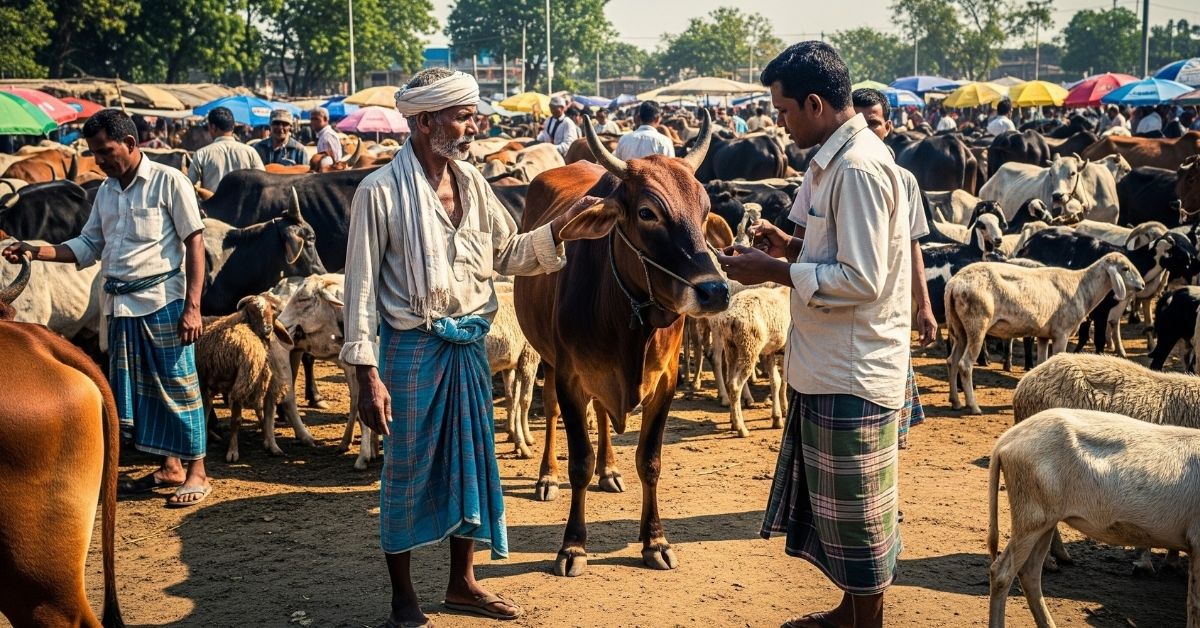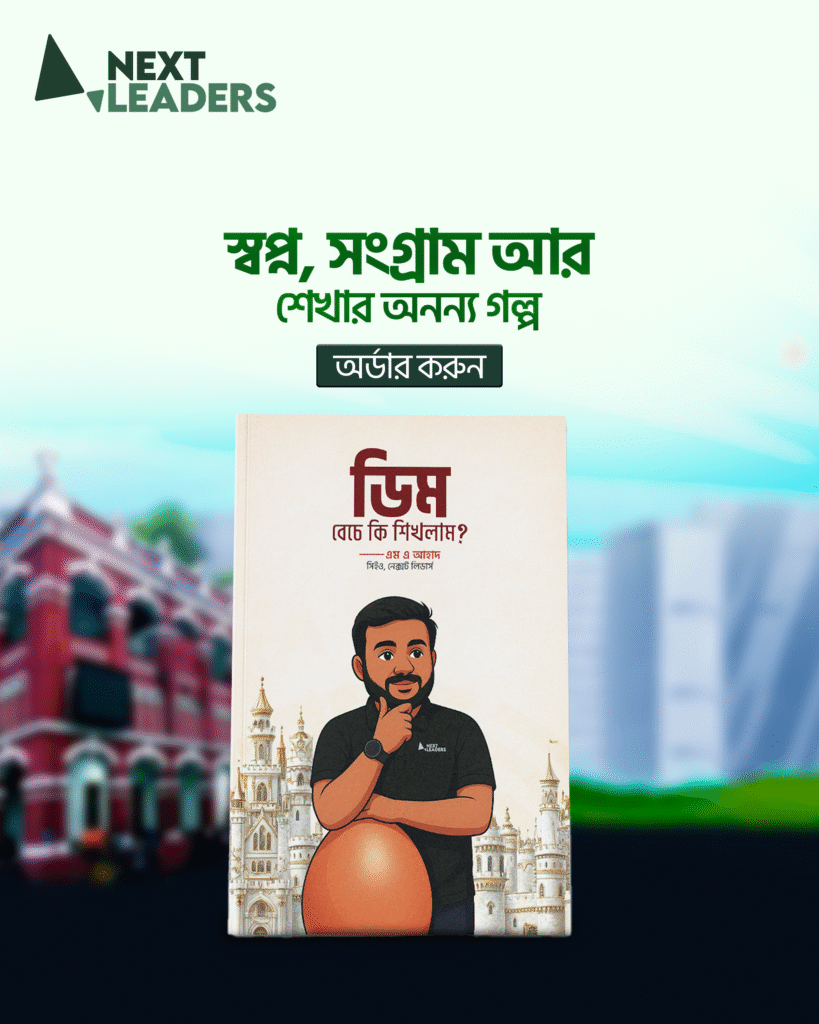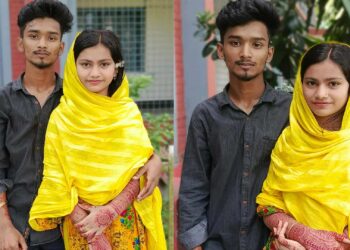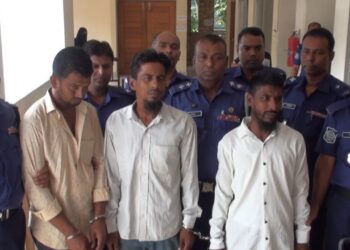1.Introduction
Eid-Ul-Adha is one of the most significant religious festival for Muslims. Eid-Ul-Adha referred to as the “Festival of Sacrifice” which celebrities annually by millions of Muslims in the hole world. This festival carry several important aspects as global, social and also economic implications. The sacrifice of livestock, mainly cow, goats and sheep which generate billions in transactions. The progresses of livestock markets, pricing trends, government interventions and evolving consumer behavior that point a complex economic picture of this religious events.
Eid-Ul-Adha has evolved into a multifaceted which influences various aspects of life especially in Muslim, not only a time for prayer and significance but also a period of massive economic activity. This festival play a vital role for most of the countries where Muslims live such as Bangladesh, India, Pakistan, Indonesia, Saudi Arabia and so on. This festival is more than a festival which vibrant tapestry woven with threads of unwavering faith, sacrifice and the joyous embrace of community. This day remind Muslims of their responsibilities not only to god but also to their communities, societies, especially those in need.
2.Historical significance of Eid-Ul-Adha
As Eid-Ul-Adha referred as the “Festival of sacrifice “sometimes called Eid II or “Greater Eid” (Arabic: العيد الكبير, romanized: al-ʿĪd al-Kabīr) ,there is a moving and symbolic stories behind the Eid. The history of sacrifice, how Prophet Ibrahim(Abraham)ready to sacrifice his beloved son to the will of Allah. This history recorded in the Quran and revered across Islamic communities. This acts as a symbol of pinnacle of faith on Allah, trust and surrender on Allah.
2.1.The story of Sacrifice
Behind every incident their must be a story and here’s also a history why Muslim people celebrate Eid-Ul-Adha by sacrificing animals life. In the Quran, Allah write the history of Eid-Ul-Adha that one night when Prophet Ibrahim(Abraham) was in deep sleep and he received a divine dream which commanding him to sacrifice his beloved son.
He through with heartbroken and accepted the instruction. He had faith on Allah and through it to be a test from Allah. He said everything to his son and his son accept his father’s word. After that Prophet Ibrahim(Abraham) prepared to carry out the sacrifice, when he going to use knife on his son’s throat Allah intervened as the last moment. Allah providing a ram to be slaughtered in Ismail’s place and this was not only a testament to the prophet’s faith for his Allah but also a lesson that true piety lies in the willingness.
2.2.Hajj Pilgrimage: The Spiritual Prelude to Eid-Ul-Adha
According to Islamic tradition, on 10th day of the Islamic month of Dhul Hajjah . The annual pilgrimage to the holy city of Makkah in Saudi Arabia which holds significance in the Islamic faith. One of the five pillars of Islam that making it an essential acts of worship for all Muslims.
Read more: 2024–2025 Fintech Outlook: Exploring Landscape & Opportunities in Bangladesh
During the Islamic month of Dhul Hajjah Pilgrimage occurs. This ritual performed during Hajj directly connect to the events. Millions of Muslims around the world perform Hajj as a sign of faith in Allah. Mainly Hajj is a physical and emotional reminder of the trials for all Muslims.
With a special congregational prayer Muslims begins this festivals, followed by the symbolic sacrifice of animals such as cows, goats, sheep, or camels. As stated in the Quran (Surah Al-Hajj, 22:37):
“It is neither their meat nor their blood that reaches Allah, but it is your piety that reaches Him.”
It is about the sincerity and devotion of the believer, not the physical act itself. The meat which get from the animal divided into three part, one is for the family, one is for relatives, friends and the last part is for poor people.
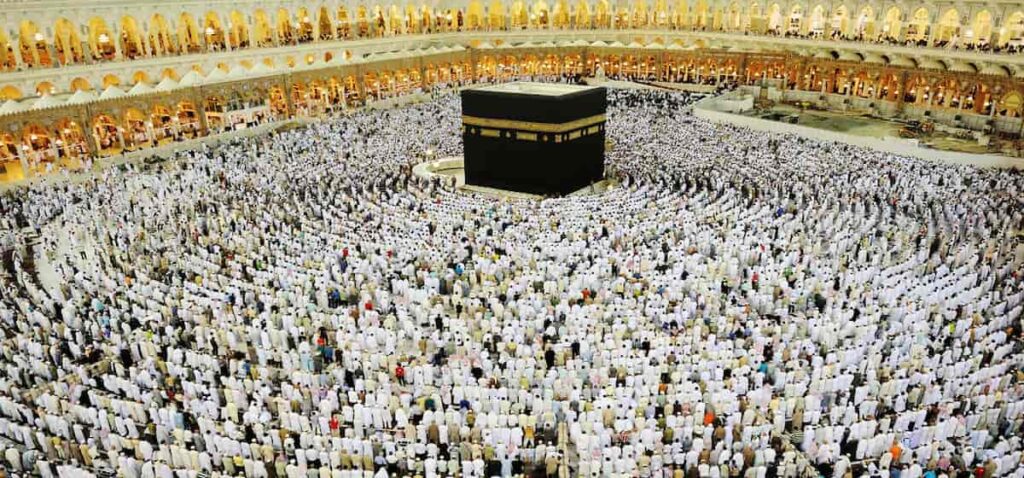
3.Rituals and Traditions of Eid-Ul-Adha
As a significant ritual for all Muslims there are several traditional practices and observation. The occur reflect of deep spiritual meaning, cultural identity and also social responsibility. They are powerful expressions of faith and unity that bring communities together across the globe. Making the festival both universally Islamic and uniquely local, customs may vary slightly across regions.
3.1. Eid prayer
Eid-Ul-Adha is begins with a special prayers. All Muslim gather in the Eidgah or open fields. Before praying they wear clean and new clothes which is a symbol of purity.
Eid prayer consists of two rakats which is followed by khutbah delivered by the imam. This khutbah accent the value of sacrifice, obedience ,humility and care for others. This reminds all Muslims about the story of prophet Ibrahim’s devotion to Allah.
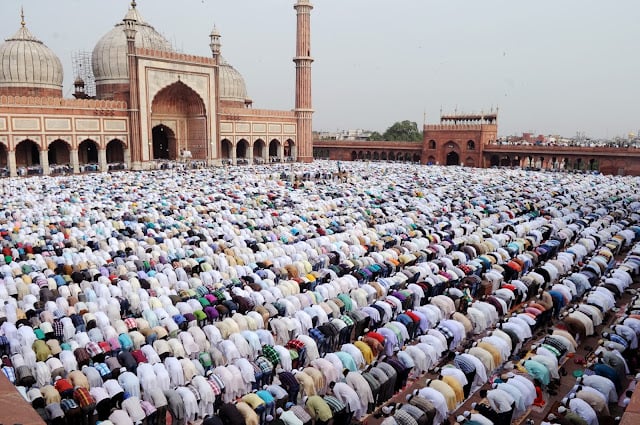
3.2.Sacrificial Offering
Qurbani, the ritual of sacrifice animals for the sake of Allah’s pleasure. Muslims can sacrifice any halal animal such as cow, camel, goat or sheep. According to the Islamic tradition, this perform after Eid prayer and for this sacrifice must needed a certain age and healthy animal. After all this, the meet need to divided into three part. One is for one is for the family, one is for relatives, friends and the last part is for poor people.
3.3.Family Gathering and Festive Meals
According to Muslim traditions, there are two Eid and this two Eid are very special for every single Muslims. Because in this era every single person is very busy in their daily activities. So they can’t give time to their friends, family, relatives. So they get the opportunity to spend quality time with they.
This Eid’s make their bonding strong. But there are variations in celebration because every single country have their own culture, traditions. So they follow their own and celebrate Eid’s.
3.4.Regional and Variation in Culture
In this world there are many countries and every single country have their own culture and traditions. As a Muslim they celebrate their Eid in own style.
As Bangladesh, in Eid-Ul-Adha there established a temporary cattle market(haats) spring up,drawing traders a d buyers from rural areas and cities alike. In Indonesia, meat is disturbing to remote villages through coordinated efforts. In Turkey, there are common to see nationwide participation in sacrifice and they share foods in formal systems.
4.Pricing Trends and Online Qurbani
Eid-Ul-Adha is not only a tradition or ritual but also it’s a significant festival for livestock. This is the largest seasonal markets in many Muslim major countries. This market have seen dramatic shifts due to inflation, urbanization and the growing influence of digital platform.
4.1.Price Trends
In the season of Eid-Ul-Adha this is becoming a hype topic of national discussion in many Muslim countries. Here’s depends several economic factors,such as rising feed and transport costs,high seasonal demand, different price gap between urban and rural area, quality and breed-based variations, economic conditions and currency fluctuation and so on.
4.2.Animal sold during Eid-Ul-Adha in Bangladesh
As we know that it’s a big time for livestock. So they have an opportunity to grab a high amount by selling animals in cattle market(haats).
If we see the price difference we can know that how much this increasing day by day. In 2020 approximately 9.45 millions animals are sold and sacrifice. In the next year 2021, because of the COVID-19 the price decreased and the number was only 9.09 million. After that, in 2022 the price break the previous record and it goes around 9.95 millon. In 2023 the price again increase and it was approximately 10.04 million. After that, the next year 2024 all records were broken and it goes about 10.41 million. Now this year hope for the best and in prediction this price may increase and again break the last year’s record.
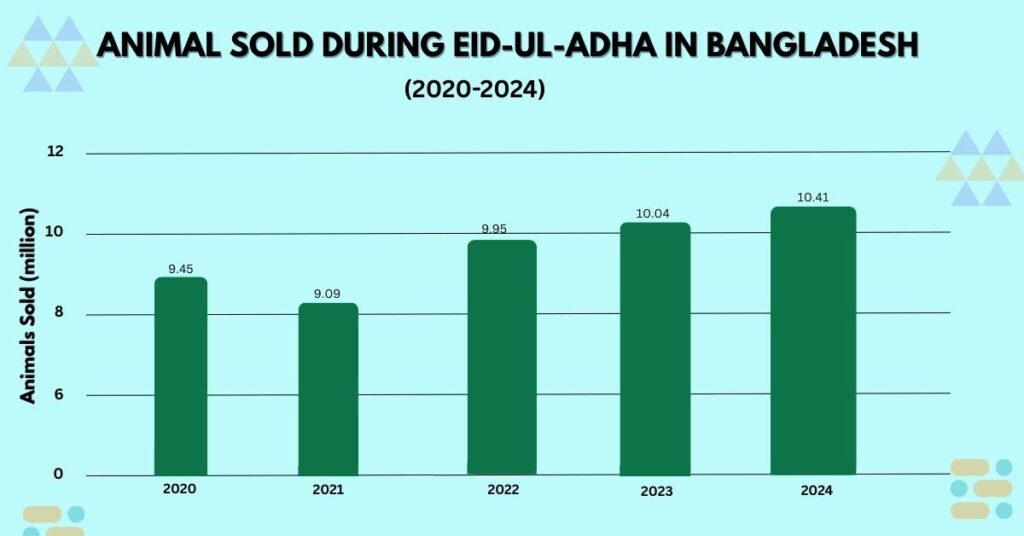
4.3.Import animal in Bangladesh during Eid-Ul-Adha
According to information last animal import in Bangladesh was in 2016. But this was not officially and it was import from India. From 2017 to Till now no animal was import for Eid-Ul-Adha.
Why they won’t import animal during Eid-Ul-Adha
There are lots of reason why Bangladesh no need to import animal. As we know Bangladesh is an agricultural country and for agriculture, in precious time they need animal for farming like cow and buffalo.
If we see, in 2020 they have sufficient local supply which is the main reason why Bangladesh doesn’t import animal. In 2021 this year people was staring focus on domestic products. So they prefer domestic animal for sacrifice. In 2023 government officially ban on import animal and that’s why people start to focus on local animal farming. In 2024, because of the local farming and people focus on domestic products it’s normal to increase animal. So that year available animal was 12.98 million and needed was 10.7 million. After that in 2025, already 12.44 million animals are ready for selling and it may increase.
For this ban, the local farmers and livestock number is increasing day by day. Decrease border tensions and illegal smuggling. They have sufficient domestic production. Also economic strategy to keep money within the local economy.
4.4.Animal price during Eid-Ul-Adha in Bangladesh
As a festival and a occasion for every single Muslims and a high time for livestock the animal price is very important for their business. It depend that how will be the next year’s price.
In 2020 the animal price was average approximately Tk 1.2 lakh. Next year 2021,the price was increase around TK 1.3 lakh. After that in 2022, the price was reaching approximately Tk 1.5 lakh. Next year 2023 the record was break and the price increase 0.3% and it goes about Tk 1.8 lakh. After the next year 2024 the price again increase 0.3% and around Tk 2.1 lakh. In 2025,this year it way increase again and predict that the price will reach approximately Tk 2.4 lakh.
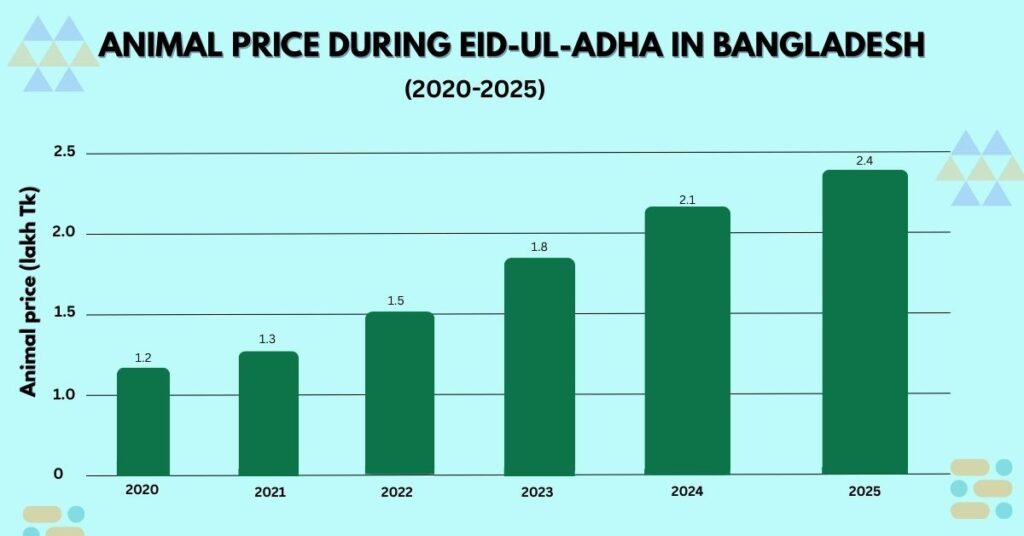
4.5. Online Qurbani
Online Qurbani means digital sacrifice animal purchasing and slaughtering. This platform mainly start from the COVID-19 pandemic. There are many reason why is grow day by day,
•Because of COVID-19 (2020-2021) lockdowns and public health fears.
•Emergency of e-commerce sites such as Digital Haat,Shwapno,Daraz,Evaly and so on.
•Offering home delivery of meat or animal.
•Islamic scholar approve this under valid terms,easing hesitations.
Growth of Online Qurbani in Bangladesh
This platform is growing day by day and from its starting till now it is increasing it’s position. Here are the growth of Online Qurbani,
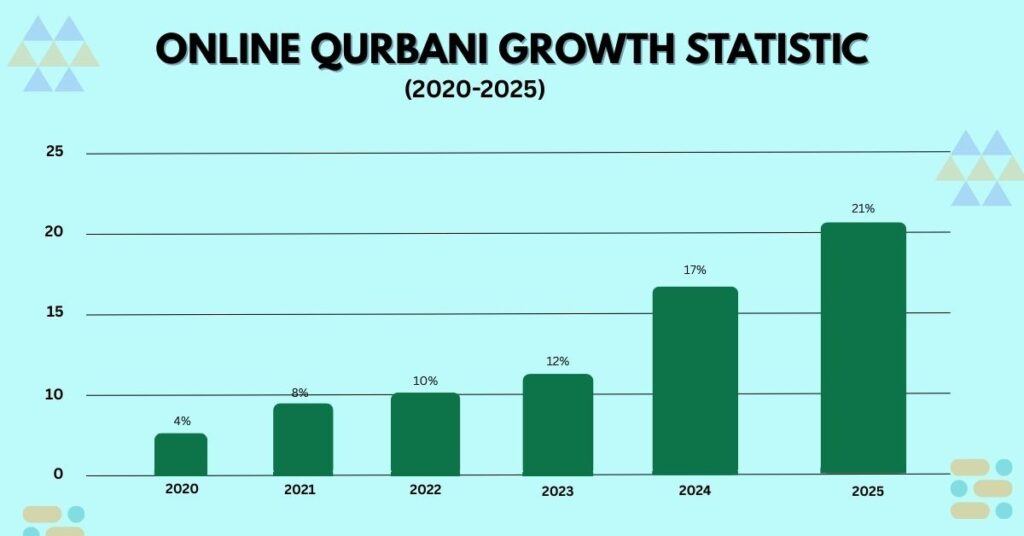
Major Online Qurbani Platforms
•Digital Haat (govt. & DNCC initiative)
•Daraz (Alibaba-backed e-commerce)
•Shwapno (retail chain)
•QurbaniHut.com, QurbaniBazaar, Khamar Bari, and various Facebook-based sellers
Benefits of Online Qurbani
There are lots of benefits, such as avoids crowded haats, minimizes infection risk, Price comparison, weight verification, payment tracking, Shariah Compliance Platforms ensure halal practices and documentation, Convenience Includes delivery of meat, animal care, and photos/videos of sacrifice and so on.
5.Economic Impact: Beyond the Animal Market
Eid-Ul-Adha is more than a festival because it’s activity, each and everything is important for a country. It will fell it’s impact on a country’s economy, culture, traditional. When the spotlight often falls on animal markets, the festival give a ripple effect across multiple sectors. This festival can occur rural economics, creating seasonal jobs, driving consumer and so on.
5.1.A Multibillion-doller Livestock Economy
Transforms into a booming seasonal industry during the weeks leading up to the festival. Every single livestock, farmers, traders, transports and market operators give their best in the month for opening profitable window.
In Bangladesh, the cattle market generates an estimated Tk 40,000 crore (approx. USD 3.5 billion) each year during Eid. In Pakistan, the Qurbani economy reportedly exceeds PKR 500 billion, encompassing sales of cattle, goats, sheep, and camels. Across countries, this surge supports a large percentage of the rural population who depend on animal rearing for their livelihood.
5.2. Rural Economics and livelihood
Small farmers and herders prepare animals for sacrifice all year, often fattening cattle with organic or commercial feed to fetch higher prices. Profits from Eid sales are used to repay loans, invest in crop production, pay school fees, or purchase household necessities. In many areas, a family’s annual income depends heavily on Eid animal sales.
5.3.Surge in Urban Economic Activity
Animal markets (haats) spring up in city suburbs, employing thousands of people including loaders, security staff, cleaners, and temporary vendors. Urban buyers often pay premiums for well-fed or imported animals, causing price spikes that create additional revenue for traders and middlemen. Transport companies especially trucks, pickups, and boats earn significant revenue by moving animals from rural areas to city markets.
Read more: Leadership Crisis or National Duty? Dr. Muhammad Yunus Refuses to Resign Amid Political Unrest
5.4.Season Employment Opportunities
Butchers earn 3 to 4 times their usual income during Eid days. Many are hired on a short-term basis and travel from one town to another. Cattle haats employ thousands for management, cleaning, ticketing, and crowd control. Online Qurbani platforms have created new-age jobs in customer service, animal photography, order processing, and logistics. Waste collectors, sanitation workers, and municipal cleaners are hired in large numbers to manage the enormous volumes of animal waste generated in cities.
5.5.Supportive Industries and Ancillary Market
•Animal Feed Industry: Feed suppliers see a spike in sales as farmers invest in fattening their cattle before Eid.
•Veterinary Services: Health check-ups, vaccinations, and deworming services are in high demand.
•Rope, knives, and tools: These small yet essential accessories become bestsellers during the Qurbani period.
•Plastic and meat packaging: With increased meat handling and distribution, demand for packaging materials shoots up.
•Cold Storage and Freezer Sales: As families seek to preserve meat for months, refrigerator and freezer sales rise significantly.
5.6.Government Revenue and Regulation
Market lease fees collected from temporary cattle haats. Transport permits, import taxes, and slaughterhouse licenses. Sanitation contracts issued to private firms for post-Eid clean-up. In some countries, meat exports are encouraged post-Eid to utilize surplus meat, bringing in foreign currency.
6.Government investment: Role and Infrastructure Management
For the country’s sake government provide some roles and infrastructure managements. This day Millions of people are engaging in sacrificing of animals that’s why it is mandatory to follow government rules. This rules are not only to support the logistical and economic framework but also to ensure safety,hygiene and regulation across the country.
6.1. Regulation and supervisor of Cattle market
Based on the Eid occasion temporary cattle markets set up in cities,towns and rural hubs. So this need to be regulated because of major disruptions,
•Designated Haats: Municipal authorities designate specific locations for temporary cattle markets. This helps reduce illegal roadside trading, traffic congestion, and health hazards in residential areas.
•Licensing and Leasing: The government, through local city corporations and municipalities, auctions or leases these markets to private contractors who operate under strict guidelines.
•Health and Safety Checks: Livestock inspectors are deployed to check the health of animals, ensuring they are disease-free and fit for sacrifice. Some areas even issue animal health certificates to maintain hygiene standards.
6.2.Transport and Traffic Management
•Animal Transport Permits: In some countries, animals crossing districts or borders require permits to regulate flow and avoid smuggling.
•Dedicated Entry Points: City authorities often designate specific roads or entry points for livestock vehicles to avoid congestion in city centers.
•Traffic Police Deployment: Additional traffic officers are deployed to manage the influx of vehicles around cattle markets and residential zones, ensuring smooth flow and preventing gridlocks.
6.3.Slaughterhouse and Butchery Regulation
•Designated Slaughter Zones: Urban municipalities set up temporary slaughter zones to discourage people from performing Qurbani in open streets, alleys, or near residential drainage systems.
•Mobile Butcher Services: In some cities, licensed butchers or mobile teams are registered with local authorities to provide hygienic, door-to-door slaughtering services.
•Slaughterhouse Management: Where formal abattoirs are used, the government ensures the availability of water, sterilization services, and waste disposal facilities.
6.4.Sanitary Service and Waste Disposal
•Sanitation Campaigns: City corporations and municipalities initiate pre-Eid cleaning drives and continue with aggressive post-sacrifice waste disposal efforts.
•Emergency Response Teams: Mobile sanitation units are on standby to collect blood, bones, and animal remains promptly, especially from densely populated neighborhoods.
•Community Awareness: Local authorities often run public campaigns urging citizens to use plastic sheets, designated dumping zones, and proper disposal bags to manage waste responsibly.
•Technology Use: In some modern cities, mobile apps are launched where citizens can report uncollected waste or request urgent clean-up services.
6.5.Ensuring Public Health
•Disease Surveillance: Monitoring is heightened for zoonotic diseases (those transmitted from animals to humans), such as anthrax, foot-and-mouth disease, and brucellosis.
•Public Safety Announcements: Government-run media outlets and health departments issue guidelines on animal handling, meat hygiene, and proper disposal practices.
•Vaccination of Livestock: In many regions, state-run veterinary services offer free or subsidized vaccinations to prevent infections among animals before they enter urban markets.
6.6.Tax Collection and Revenue
•Entry Fees and Toll Taxes: Livestock entering city limits are often taxed based on size and number.
•Market Leasing Revenue: The leasing of cattle markets to contractors generates millions in income for municipal bodies.
•Slaughterhouse Fees: Licensed slaughterhouses often charge a nominal fee per animal, contributing to public funds.
•Formalization Efforts: By encouraging online platforms and certified traders, the government ensures better record-keeping and formal economic integration.
6.7.Security and Crowed Management
•Police and RAB Patrols: In countries like Bangladesh, Rapid Action Battalions and police forces are deployed in cattle haats to prevent theft, fraud, and disputes.
•Surveillance Systems: CCTV cameras are often installed in large markets to monitor illegal activities and ensure the safety of buyers and sellers.
•Emergency Services: Fire brigades, medical tents, and ambulance units are kept on standby, especially in large urban zones.
Conclusion: Eid-Ul-Adha as a Force for Good
Eid-Ul-Adha is a festival of faith, sacrifice and submission to the Allah. This festival remind us the history of Prophet Ibrahim (Abraham). It plays a significant role in fueling rural economics, activating urban markets and generating employment across multiple sectors.
In Muslim countries as Bangladesh, Pakistan, Afghanistan and others with vibrant Muslim population, this occasion become massive economic engine, touching the lives of millions. With the rise of online Qurbani platforms, evolving government infrastructure, and growing public awareness about hygiene and sustainability, Eid-Ul-Adha is also becoming a symbol of modernization within tradition.
This festival also bring challenges as overcrowded cattle markets, waste disposal, disease risk and economic inequality. Government also helps to occur this traditions with safety, security and they take all steps for country’s betterment.
Until we just giving up our beloved valuable things we won’t understand the value, Eid-Ul-Adha is the Eid for where we can understand the value. It carries with it the enduring message of devotion, unity and hope for a better and more inclusive future.
Reference
Prothom Alo
Wikipedia
Dhaka Tribune
The Daily Ittefaq
The Financial Express
The Daily Star
BSS
Banglanews24.com
Jagonews24
The Business Standard
Share via:

